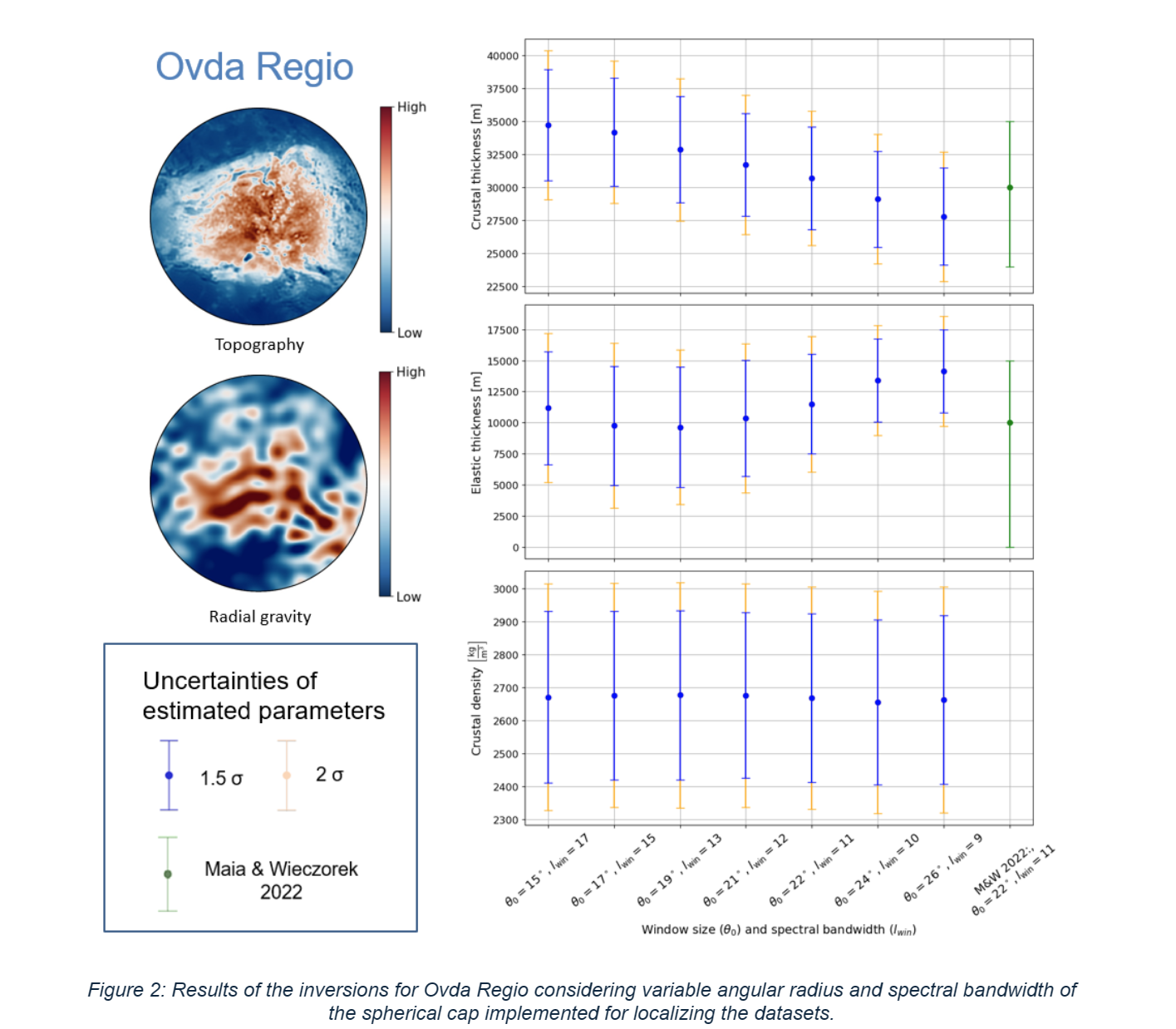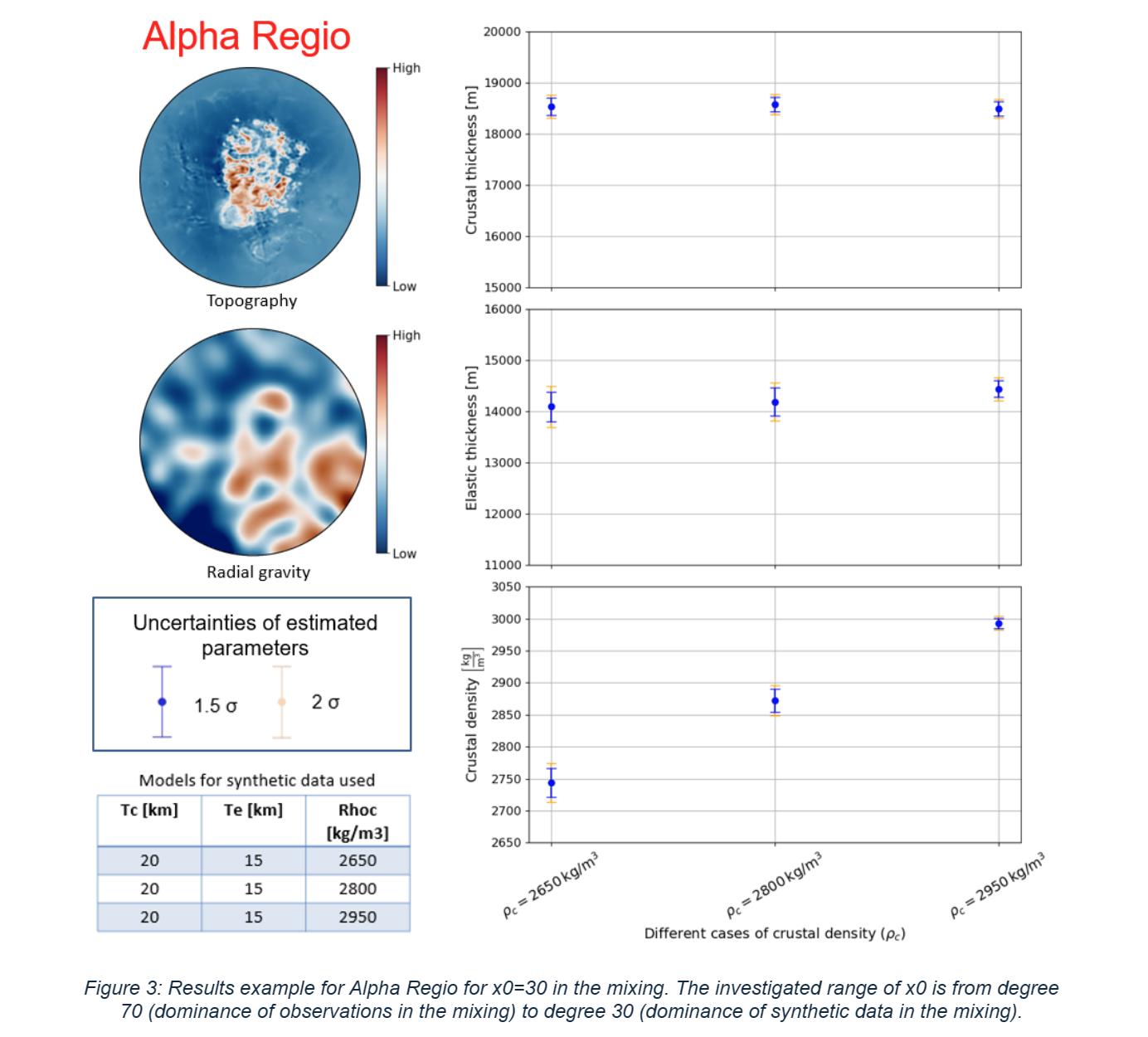Constraining the interior structure of crustal plateaus on Venus in the context of future space missions.
- 1Institute of Planetary Research, German Aerospace Centre (DLR), Berlin, Germany
- 2Aerospace Engineering Faculty, Delft University of Technology, Delft, The Netherlands
- 3University of Maryland Baltimore County, Baltimore, Maryland, USA
- 4NASA Goddard Space Flight Centre, Greenbelt, Maryland, USA
- 5NASA Jet Propulsion Laboratory, Pasadena, California, USA
Crustal plateaus are large, high elevation physiographic features on Venus associated with the strongly deformed tessera terrains. They present positive, low magnitude gravity anomalies, and they are stratigraphically the oldest surfaces on the planet [1]. Previous investigations of the gravity and topography signatures of the plateaus have shown that these regions are consistent with shallow support via crustal thickening [2, 3]. In addition, surface emissivity data obtained by Venus Express have shown that the plateaus are associated with low emissivity anomalies, which could be indicative of a felsic composition [4]. Given these observational data sets that are summarized in Figure 1 for Alpha Regio, crustal plateaus could be analogues to the continents on Earth, which would have major implications for our understanding of the tectonic and geodynamic processes that operated throughout Venus’ evolution. Therefore, a careful investigation of the origin and evolution of these features is one of the main objectives of the future missions to Venus.
The goal of this study is to quantify how much the future gravity datasets, in particular obtained by the VERITAS mission, will help us constrain the interior structure of plateaus. We focus on crustal density estimations, since the density would give essential information about the potential felsic composition of the crustal plateaus.

Here, we build on the research and methods of Maia & Wieczorek [3], but we adopt a different inversion approach and focus only on surface loads. To this end, we use a two-layer (mantle, crust+load) lithospheric flexural model. In our inversion, the admittance, a measure of the response of the gravity field to variations in topography, is the physical quantity that is compared between model and observations. The admittance is then spatially and spectrally localized using the windowing functions developed by Wieczorek & Simons [5], to focus the analysis on the plateau regions of interest (here, Alpha Regio and Ovda Regio). A Bayesian inversion to retrieve the parameters of crustal plateaus (i.e., crustal thickness Tc, elastic thickness Te, crustal density ρc) is carried out using the Dynesty package [6] that implements a Nested Sampling algorithm.
Results using current low resolution gravity data show some improvements on the uncertainties of crustal and elastic thickness in comparison to [3] (Figure 2). In particular, our inversions were able to retrieve a lower bound of about 5 km for the elastic thickness of Ovda Regio. However, as expected, the plateau’s crustal density remains unconstrained within the explored range (2400-3000 kg/m3). The slight variability of the results for different window sizes is caused by uncorrelated gravity anomalies not related to the crustal plateau.

These resolution limitations will be soon overcome, thanks to the improvements expected with the VERITAS and EnVision missions, to be launched in the early 2030s to study Venus. In particular, thanks to its quasi-circular orbit, VERITAS will obtain a gravity model with degree strength globally larger than degree 160 and over degree 200 in some regions [7]. Thus, the second focus of this study is to provide a first impression of the extent to which this new dataset will improve our knowledge about the interior structure of the crustal plateaus.
For the simulated gravity dataset, we use flexural models up to spherical harmonic degree 180, for which we consider 6 different variations of the parameters of interest (Tc=20 km, Te=15/30 km, ρc=2650/2800/2950 kg/m3). In a second step, simulated noise is added, and the synthetic data is then mixed with the currently measured gravity field with a sigmoid (logistic function). By changing parameters of this function, such as the steepness of the curve (k) and the degree at which the growth occurs (x0), the mixing can be controlled. This new simulated gravity dataset is used together with our inversion process to study the impact of the higher degree gravity field on our results and test our ability to retrieve the parameters of the crustal plateaus (Tc, Te, ρc).
We observe that, by including more synthetic data compared to the measured gravity field, our inversion is able to retrieve the parameters of the crustal plateaus within 10% of the true value known from the synthetic models (see results in Figure 3 for Alpha Regio). We show that the uncertainties of the crustal plateau parameters substantially decrease when the maximum degree of the gravity field that is used in our inversions increases. Our results demonstrate that such an approach would be able to distinguish between a high density, basaltic crust and a low density more felsic crust.

Future developments will investigate different sources of noise that can be added to the admittance, such as geologic signals not related to flexural support. A natural next step is to apply this analysis to different crustal plateaus to determine the potential of retrieving crustal density estimates at various locations on Venus. Finally, we will perform additional sensitivity tests for our inversion approach to assess its robustness to various additional input parameters.
References:
[1] Ivanov M.A. & Head J.W. (2011) Planet. Space Sci., 59; [2] Grimm R.E. (1994) Icarus, 112 ; [3] Maia J.S. & Wieczorek M.A. (2022) JGR Planets, 127; [4] Gilmore M.S. et al. (2015) Icarus, 254; [5] Wieczorek M.A. & Simons F.J. (2007) JFAA, 13; [6] Speagle J.S. (2020) MNRAS, 493; [7] Cascioli G. et al. (2024) 55th LPSC.
How to cite: Baccarin, J., Maia, J., Cascioli, G., Plesa, A.-C., Mueller, N., Mazarico, E., Breuer, D., and Smrekar, S.: Constraining the interior structure of crustal plateaus on Venus in the context of future space missions., Europlanet Science Congress 2024, Berlin, Germany, 8–13 Sep 2024, EPSC2024-817, https://doi.org/10.5194/epsc2024-817, 2024.